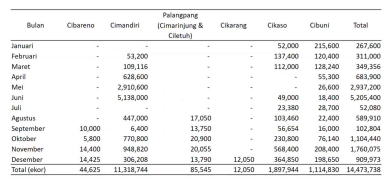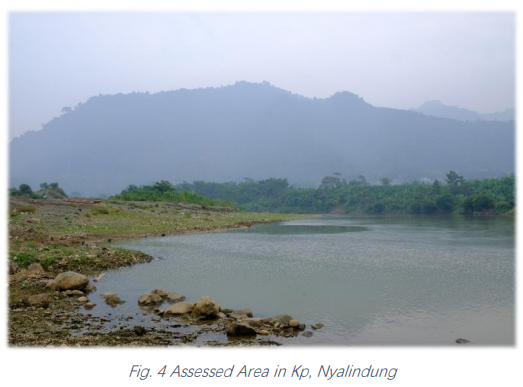1. Cimandiri River
Cimandiri is the main river where most of glass eel production are taken place. It contributes around 78% of the total glass-eel atchment (Fig. 2). Based on this condition, MFO and local communities & fishers hope that the stocking will be taken place in Cimandiri to balance the production rate. In past, there were various ell stocking attempts conducted in this river, which most (if not all) were organized by PT. Iroha.
There are 2 river segments that were assessed in Cimandiri: 1 located in Kp. Mariuk and and the other in Kp. Cikadu (Fig. 3). Kp. Mariuk is a location that was proposed by MFO for stocking site, while Kp. Cikadu is an alternative potential site that was proposed by MFO and locals during the assessment process.
Fig. 2 Glass-eel production from some major rivers in Sukabumi (2018)
Fig. 3. Two assessed river segments of in Cimandiri River:
1. Kp. Mariuk (07°01'01,6" S; 106°34'51,7" E)
2. Kp. Cikadu (06°59'51,6" S; 106°36'23,1"E)
a. Kampung (Kp.) Mariuk
Kp. Mariuk is a small settlement located in Cidadap Subdistrict. Fisheries Office proposed a river segment in this area as the priority location for eel stocking. This location was also beselected for previous eel stockings which are conducted by PT. Iroha.
Although this location previously selected for stocking site, there were various environmental issues around the area that can be seen clearly. First, there is an active sand mine right at the next of the stocking site. This mine alters land covers around the area and supply additional pollutants into the rivers. Second, riparian vegetation along the river is very limited and not suitable for eel habitat.
b. Kampung (Kp. Cikadu)
Kp. Cikadu is located in Pelabuhan Ratu Subdistrict. Although pollution input is still visible at the assessed area, riparian vegetation along the river is much denser compared to Kp. Mariuk. Stones, which may provide natural shelter/refugia for eels are also plenty in the upstream side of this area. These conditions offer suitable habitat condition for eels after their releasement, which may increase their survivability.
Some fisheries practices were found during the assessment (fishing rod and nets). None of these practices are specifically set to catch eel.
Additionally, the assessed area was very close to Balai Benih Ikan (BBI) Tonjong. Since BBI Tonjong is planned to be involved in IFish’s eel stocking program in Sukabumi (as eel provider and facility for eel tagging process; see Recommendation section for detailed information), this location offers efficiency for various stocking preparation activities.





No Comments